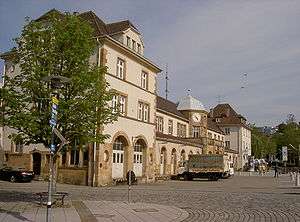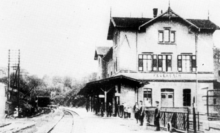Stuttgart-Feuerbach station
| Through station | ||||||||||||||||||||||||||
 | ||||||||||||||||||||||||||
| Location |
Wiener Platz 2, Feuerbach, Baden-Württemberg Germany | |||||||||||||||||||||||||
| Coordinates | 48°48′49″N 9°10′8″E / 48.81361°N 9.16889°E | |||||||||||||||||||||||||
| Owned by | DB Netz | |||||||||||||||||||||||||
| Operated by | DB Station&Service | |||||||||||||||||||||||||
| Line(s) | ||||||||||||||||||||||||||
| Platforms |
1 island platform 1 side platform | |||||||||||||||||||||||||
| Tracks | 4 | |||||||||||||||||||||||||
| Train operators | S-Bahn Stuttgart | |||||||||||||||||||||||||
| Connections |
S 4 S 5 S 6 S 60 U6 U13 | |||||||||||||||||||||||||
| Other information | ||||||||||||||||||||||||||
| Station code | 6078[1] | |||||||||||||||||||||||||
| DS100 code | TSFE[2] | |||||||||||||||||||||||||
| IBNR | 8005770 | |||||||||||||||||||||||||
| Category | 4[1] | |||||||||||||||||||||||||
| Fare zone | Verkehrs- und Tarifverbund Stuttgart | |||||||||||||||||||||||||
| Website | www.bahnhof.de | |||||||||||||||||||||||||
| History | ||||||||||||||||||||||||||
| Opened | 15 October 1846 | |||||||||||||||||||||||||
| Services | ||||||||||||||||||||||||||
| ||||||||||||||||||||||||||
| Location | ||||||||||||||||||||||||||
 Stuttgart-Feuerbach Location within Baden-Württemberg | ||||||||||||||||||||||||||
Feuerbach station is an S-Bahn station in the Stuttgart borough of Feuerbach in the German state of Baden-Württemberg. It is on the Franconia Railway. The station is classified by Deutsche Bahn as a category 4 station[1] and is classified as a haltepunkt (halt) because it now has no operable sets of points.
History
Feuerbach station was opened by the Royal Württemberg State Railways (German: Königlich Württembergische Staatsbahn) along with the Central Railway (Centralbahn) from Stuttgart to Ludwigsburg on 15 October 1846. It is one of the oldest stations in Württemberg. At that time it was about a kilometre outside the village, along the road towards Cannstatt. The old one-story station building was erected about 200 metres from the Prag Tunnel.


In 1852, a second track was completed on the Northern Railway between Stuttgart and Bietigheim. Industrialisation had begun in the former wine-growing community of Feuerbach. In 1864, the Jobst company established its first major plant for the production of quinine. In 1871 and 1872 the first extensions were added to the station. Another floor was added to the entrance building and a large freight yard was built. In the late 19th century the station was one of the busiest in Württemberg.
The volume of passenger and freight traffic continued to grow. More large companies, such as Leitz and Bosch (1910), were established. On 15 March 1907, the government gave Feuerbach a charter as a city as its population had risen to about 12,000. The little station could no longer cope with its traffic and needed alterations. A larger entrance building and freight yard were required. The planning and management of construction were provided by the administration of the State Railways, while the Stuttgart-based architects firm of Bihl & Woltz was commissioned to design the facade. In 1909, the modern station building was inaugurated. The building was planned so that passengers could enter from the station forecourt at ground level. The platforms were raised to the first floor level. This design was new in Württemberg.
The building consists of a long two-storey central building with two three-story wings. In the middle is the entrance and above it there is a small tower with two clocks.
On 26 May 1929, Deutsche Reichsbahn completed the quadruplication of the line between Stuttgart Central Station and Feuerbach. On 1 May 1933, Feuerbach was annexed by the city of Stuttgart. The electrification of two tracks for suburban operations between Stuttgart Central Station and Ludwigsburg began on 15 May 1933. The station was renamed Stuttgart-Feuerbach on 1 June 1933.
Restructuring as part of Stuttgart 21
As part of the Stuttgart 21 project the Feuerbach tunnel will be built to the south of the station, surfacing near Kruppstraße. The new line will rise up a ramp in the station and connect to the mainline tracks to its north. During construction the two long-distance platform tracks and the eastern outer platform will be demolished. A new pedestrian underpass will be built to a new platform. Then the new tracks will be built through the station. Rail operations will be maintained throughout the work.[3]
Rail operations


The station has four through tracks and a bay platform. Track 1 is used by the S-Bahn from Stuttgart central station and track 2 by the S-Bahn towards Zuffenhausen. Tracks 3 and 4 serve long-distance traffic. Services of the Württembergische Eisenbahn-Gesellschaft (Württemberg Railway Company) bound for the Strohgäu Railway start on track 1a (the bay track) during peak hours. The station is classified by Deutsche Bahn as a category 4 station.[1]
S-Bahn
| Line | Route |
|---|---|
| S 4 | Backnang – Marbach – Ludwigsburg – Zuffenhausen – Feuerbach – Hauptbahnhof – Schwabstraße |
| S 5 | Bietigheim – Ludwigsburg – Zuffenhausen – Feuerbach – Hauptbahnhof – Schwabstraße |
| S 6 | Weil der Stadt – Renningen – Leonberg – Zuffenhausen – Feuerbach – Hauptbahnhof – Schwabstraße (additional services in the peak between Leonberg and Schwabstraße) |
| S 60 | Böblingen – Sindelfingen – Magstadt – Renningen – Leonberg – Feuerbach – Zuffenhausen – Hauptbahnhof – Schwabstraße |
Regional Transport
| Line | Route |
|---|---|
| WEG R61 | (Feuerbach – Zuffenhausen –) Korntal – Hemmingen – Heimerdingen – Weissach |
Stadtbahn
The terminus of the Feuerbach Municipal Tramway (Städtische Straßenbahn Feuerbach) was formerly located in the station forecourt. Today lines U 6 and U 13 of the Stuttgart Stadtbahn stop at Wiener Platz at the north-western end of the station.
| Line | Route (1435 mm gauge) |
|---|---|
| U6 | Gerlingen – Weilimdorf – Feuerbach – Hauptbahnhof – Degerloch – Möhringen (– Fasanenhof) |
| U13 | (Giebel –) Feuerbach – Pfostenwäldle – Pragsattel – Bad Cannstatt – Hedelfingen Only between Feuerbach and Hedelfingen during school holidays and off-peak. |
Notes
- 1 2 3 4 "Stationspreisliste 2018" [Station price list 2018] (PDF) (in German). DB Station&Service. 5 October 2017. Retrieved 14 December 2017.
- ↑ Eisenbahnatlas Deutschland (German railway atlas) (2009/2010 ed.). Schweers + Wall. 2009. ISBN 978-3-89494-139-0.
- ↑ DB ProjektBau, Projektzentrum Stuttgart 1 (ed.). Stuttgart 21: Zuführung Feuerbach und Bad Cannstatt mit S-Bahn-Anbindung (in German). p. 4 (14 page brochure with status of August 2003)
References
External links
| Wikimedia Commons has media related to Stuttgart-Feuerbach station. |
- "Station track plan" (PDF) (in German). Deutsche Bahn. Retrieved 12 January 2012.